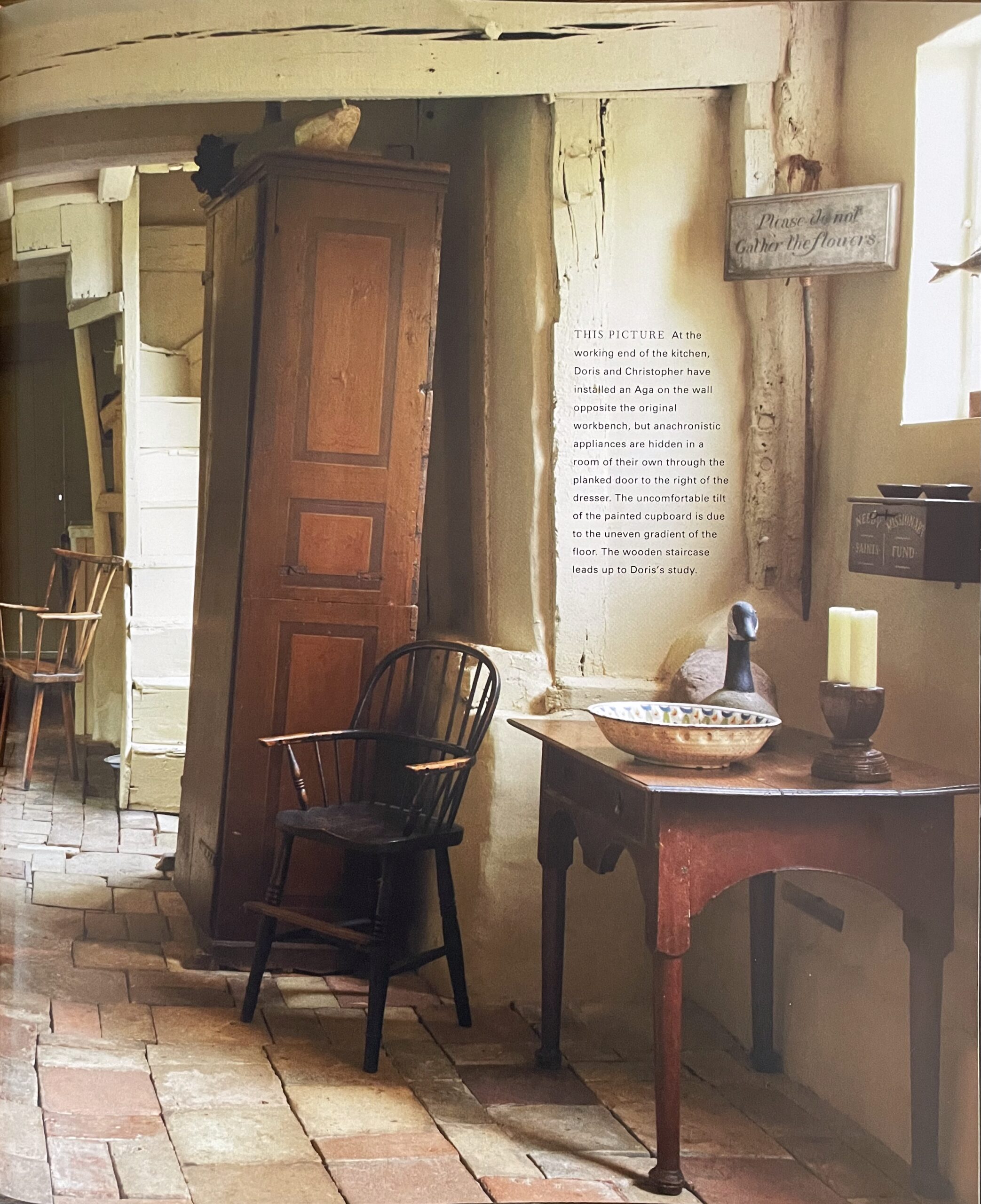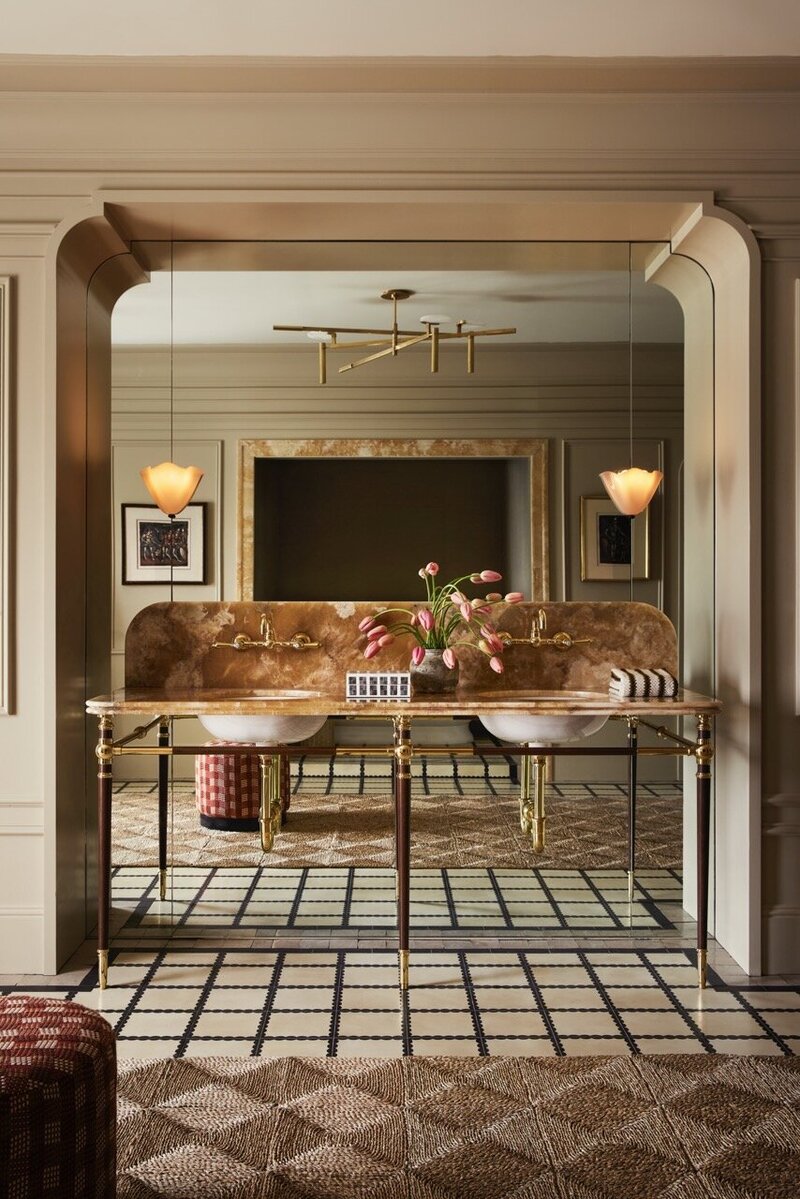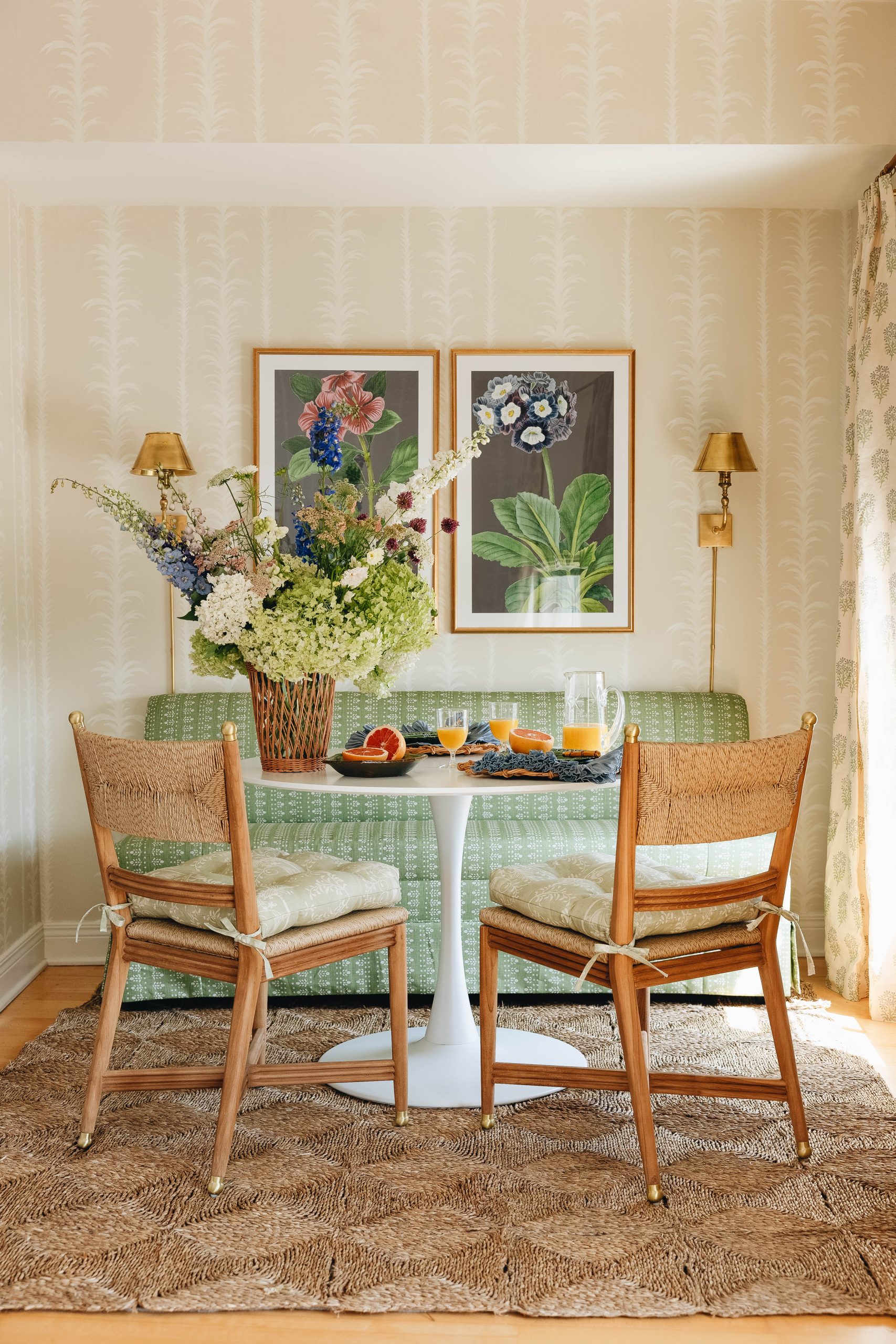Dear Danica, What Paint Colors Look Best With Orange Wood Floors? (Plus Sloped Floors & Exterior Colors I Like)
·

Today I’m addressing several very relatable design dilemmas! From finding ways to infuse warmth into a bathroom while on a tight budget, working with sloped floors in an old home, picking the perfect white-beige paint color for an exterior, and selecting paint colors that complement warm/orange wood floors. Do you resonate with any of these dilemmas? Read on!
This post contains affiliate links.

Dear danica,
We just purchased our first house and we’ve been pretty unlucky (new french drain and membrane outside), having to redo the whole exterior, new bathroom, baby room (our firstborn), we are all over the place. We redid the bathroom because it was horrendous. Because of lack of budget, I couldn’t get the vanity I wanted (some wooden vanity) and had to settle for the white generic one… I don’t like my bathroom, it’s missing warmth and character. Can you please help!
– Sorgente
Congratulations and I’m sorry! That’s so stressful to discover so many unexpected (and costly) expenses. I’d love to help! In terms of adding warmth, that can easily be done with some paint and updated hardware. How comfortable are you with color? The more you infuse color on a grand scale, the more opportunity you’ll have to create depth, warmth, and character without making major changes. Color does wonders! Two color palettes I’ve been loving recently are:

Color Palette Option No. 1: Brinjal, Dibber, and Oxford Stone from Farrow & Ball. Color Palette Option No. 2: Reduced Green, Kakelugn, and Matchstick by Farrow & Ball. Once you pick a palette, select one of the colors for the walls, a second color for your cabinetry, and the third color can be your pop of color through the shower curtain, towels, rug, etc.
Other simple updates like a wood toilet seat cover, brass knobs on the vanity and cabinets, and a wood mirror will make a big impact. And if you have the bandwidth, I would consider adding a division between the laundry and the toilet. Either a wall that’s the depth of the washer and dryer or a fully enclosed closet – either would “clean it up” visually.
Dear danica,
I live in a 100 yr old 2 story farmhouse in VA and I love it. However, my floors are wonky – a couple of inches in some spots around the edges in a room upstairs. So beyond pulling up the original pine boards to level, I have to live with them and I can’t quite figure out how to make the furniture look level without putting something under the front edges/legs. But then you see it and it looks weird. Any thoughts?
– Kristi
I secretly love when old homes have sloped floors. It really adds to the charm and I fully appreciate when homeowners keep the floors as is (assuming structural repairs have been made). The Restoration Drama house in the book Perfect English Farmhouse is a perfect example of embracing sloped floors. See below –


If your home was newer (or had been renovated to look new) I could understand one’s desire to make the unlevel floors less obvious. But in old homes, wonkiness is welcome. The house clearly isn’t “perfect”, so it’s not unreasonable to use imperfect methods to remedy the situation. If anything, it adds to the quirkiness of the home. For dressers, chairs, or nighstands that need to be leveled, bun feet of various heights or custom leg extensions would be the least noticeable remedy. A long bed skirt would hide the stack of wood used to level the bed frame. But perhaps the easiest trick is strategic layering. A blanket basket would perfectly hide the dresser leg that’s propped on a block of wood.

Dear danica,
We recently moved into our first home, we love it but it’s a very small house. Don’t have the money to renovate right now so I need help with a living room furniture layout that makes sense! Do I add two swivel chairs facing the couch? Something else? I’m super stuck and need help, thanks!!
– Sarah
Congratulations! Your home is really charming and it looks like the perfect first home! I like your idea, two swivel chairs across from the couch that can turn to face the TV if needed. I would also look into buying a bigger rug that fits under all the feet of your furniture – like this or this. Trust your instincts, you’re doing great! Linking a few swivel chairs I like for you –
Affordable Swivel Chairs:
SCROLL RIGHT TO VIEW FULL LIST →
Dear danica,
Need help with a warm beige-white paint color for exterior vinyl siding. Would like to use Behr. Potentially color matching FB School House White.
– Kassey
Fun fact, School House White by Farrow & Ball was my top pick for our own home exterior. It’s a perfect warm white that doesn’t lean too yellow or too bright. The only reason we didn’t end up using that color was because we tried to color match it, and after 4-5 failed attempts from numerous paint brands, we gave up and went with an entirely different color.
Four warm white paint colors I love for exteriors are:
- School House White – Farrow & Ball
- Shadow White – Farrow & Ball
- Neutral Ground – Sherwin Williams (see an example here)
- Natural Choice – Sherwin Williams
Keep in mind, color matches rarely match the original color. You will always get the most accurate color when you order directly from the brand who made the color. However, if you choose to try color matching, follow the guidelines outlined in this article to save yourself a headache.

Dear danica,
I bought my first house two weeks ago and we love it because it is unique with character. But I am not sure how to choose furniture and paint colors with the different colored wood throughout the house. Current furniture (TV stand, bookshelves, desks, and bed) is black/dark brown wood. I want to keep the warmth of the home’s floor and wainscoting as-is but I am open to paint the trim and we need to buy new furniture anyway.
– Valerie
So many readers have just purchased their first home! That’s so exciting! Ok, so there are two concerns we’re addressing: 1) You’re not sure what wood tones look best with your existing wood floors and wainscoting. 2) You’re looking for paint colors that will complement the existing wood tones in the home. Let’s start with the wood furniture concern.
WOOD TONES: I always recommend using at least 2 different wood tones in the home. The easiest way to pick multiple wood tones is to pair dark wood with medium or light wood. Then, to ensure the wood tones complement each other, make certain the two colors have the same undertone. Wood with a hint of orange, yellow, or red has a warm undertone. Wood with a gray or blue tint is cool toned. And wood that is neither orange nor gray is considered neutral. Pick one dark and one medium/light wood with the same undertones for all flooring, millwork, and furniture.
In your case, the wood floors have a warm yellow and orange undertone and would pair best with dark warm wood furniture.
PAINT COLORS: There are two routes you can go when picking paint colors for warm/orange floors – either enhance the color or neutralize it. White, red, yellow, and orange will further accentuate the orange coloring in the wood. Blue, green, and purple will neutralize it. In your case, I would recommend either a dusty pale green or a muddy pale blue to contrast and neutralize the intensity of the flooring and wainscoting. As for the trim, I would paint that the same color as your walls.
Do you have a design dilemma you want help with?
Every month I help readers find solutions to their dilemmas, for free!
Leave a Reply Cancel reply
DO YOU WANT
The Inside Scoop
Where behind the scenes, exclusive advice, and candid conversations are sent straight to your inbox every week.


Thank you for addressing my dilemma! I love the ideas you suggested and I do own that book. I’ll have to take a closer look. I do love my original floors and will brace the wonkiness of them. Appreciate you taking the time.
Absolutely! So glad you’re embracing the quirkiness of the floors! 🙂
Our daughter has a 125-year-old stone house. Her kitchen is quite sloping, and I think it’s charming. As long as you don’t fall down, nothing wrong with that! A remedy for furniture not looking level that you didn’t mention is to shorten the back or front legs, depending on where the dips are. We have done this on too-straight kitchen chairs a number of times, to make them more comfortable. We have also used shims, which are unnoticable under cabinets.
All great ideas! Lots of remedies that don’t require much effort 🙂